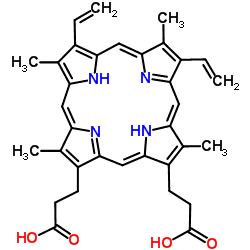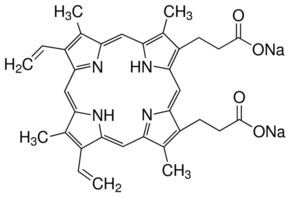Molar mass 562.6581 g/mol | Formula C34H34N4O4 | |
 | ||
Protoporphyrin IX is an organic compound, which is one of the most common porphyrins in nature. It is a deeply colored pigment that is soluble in basic water. The free porphyrin is encountered in nature in the form of its iron complexes. When complexed with ferrous iron, the molecule is called heme. Hemes are prosthetic groups in some important proteins. These heme-containing proteins include hemoglobin, myoglobin, and cytochrome c. Complexes can also be formed with other metal ions, such as zinc.
Contents
- Protoporphyrin IX biosynthesis
- Heme b biosynthesis
- Chlorophyll biosynthesis
- Synthesis of iron derivatives
- References

Protoporphyrin IX biosynthesis

Its biosynthesis is mediated by the enzyme protoporphyrinogen oxidase. Protoporphyrin IX is an important precursor to biologically essential prosthetic groups such as heme, cytochrome c, and chlorophylls. As a result, a number of organisms are able to synthesize this tetrapyrrole from basic precursors such as glycine and succinyl CoA, or glutamate. Despite the wide range of organisms that synthesize protoporphyrin IX the process is largely conserved from bacteria to mammals with a few distinct exceptions in higher plants.
Heme b biosynthesis
In heme biosynthesis, the enzyme ferrochelatase converts it into heme b (i.e. Fe-protoporphyrin IX or protoheme IX).
Chlorophyll biosynthesis
In chlorophyll biosynthesis, the enzyme magnesium chelatase converts it into Mg-protoporphyrin IX.
Synthesis of iron derivatives
Protoporphyrin IX reacts with iron salts in air to give the FeCl(PPIX).


